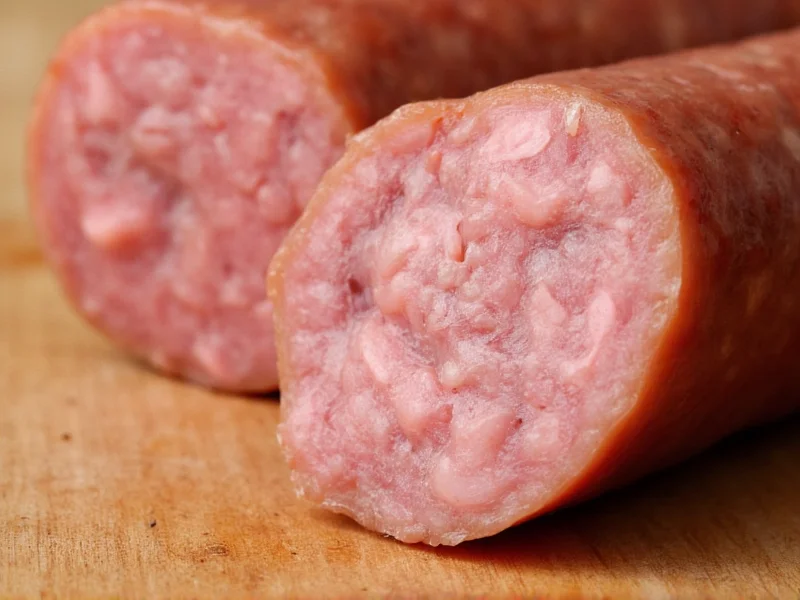Why 160°F Is the Critical Temperature for Pork Sausage
Understanding the science behind pork sausage cooking temperatures is essential for food safety. Unlike whole muscle cuts of pork that can be safely cooked to 145°F with resting, ground pork products like sausage require a higher temperature due to increased surface area exposure during grinding.
When pork is ground to make sausage, any bacteria present on the exterior becomes distributed throughout the product. The USDA Food Safety and Inspection Service mandates that ground pork products reach 160°F to eliminate pathogens that cause foodborne illness. This specific temperature threshold ensures destruction of:
- Salmonella (common in raw pork)
- E. coli O157:H7
- Trichinella spiralis (though rare in commercial pork)
- Listeria monocytogenes
Proper Temperature Measurement Techniques
Accurate temperature verification requires proper thermometer use. Many home cooks make critical errors when checking pork sausage doneness:
| Correct Method | Common Mistake |
|---|---|
| Insert thermometer into thickest part of sausage | Measuring near casing or edge |
| Wait 10-15 seconds for stable reading | Checking too quickly |
| Test multiple sausages in batch | Checking only one piece |
| Clean probe between measurements | Cross-contaminating with same probe |
Digital instant-read thermometers provide the most reliable results for home cooks. Calibrate your thermometer monthly using ice water (32°F/0°C) or boiling water (212°F/100°C at sea level) verification methods.
Visual Indicators vs. Temperature Readings
Many home cooks rely on visual cues like color change or firmness to determine pork sausage doneness. This practice is dangerously unreliable. Pork sausage may appear fully cooked at temperatures as low as 140°F, while still harboring harmful bacteria.
The pink color sometimes remaining in properly cooked sausage results from:
- Nitrites in cured products
- Myoglobin retention in fatty formulations
- Reaction with certain spices
Only a properly calibrated food thermometer provides definitive safety verification. The USDA explicitly states that color is not a reliable indicator of doneness for any meat product.
Resting Period Considerations
Unlike whole cuts of meat, ground pork products like sausage don't benefit significantly from resting time. The temperature doesn't continue to rise substantially after removal from heat due to the product's structure.
When cooking sausage patties or links:
- Remove from heat source immediately upon reaching 160°F
- Serve promptly to maintain optimal texture
- Do not expect carryover cooking to raise temperature significantly
Variations Across Sausage Types
While 160°F applies to standard pork sausage, certain specialty products have different requirements:
- Pre-cooked sausages: Only require reheating to 140°F
- Smoked sausages: Should reach 160°F if raw, but only 140°F if fully cooked
- Breakfast sausage: Follow standard 160°F guideline
- Italian sausage: Same temperature requirement despite seasoning differences
Always check packaging for specific preparation instructions, as some commercial products may contain fillers or binders that affect cooking properties.
Common Temperature Verification Mistakes
Food safety professionals observe several recurring errors when testing pork sausage temperatures:
- Thermometer placement: Inserting too close to the casing or at an angle that measures surface rather than core temperature
- Batch inconsistency: Assuming uniform temperature across multiple sausages when cooking in batches
- Thermometer calibration: Using devices that haven't been verified for accuracy
- Time pressure: Rushing the cooking process and checking temperature prematurely
For optimal safety, test multiple sausages in each cooking batch, especially when using methods like grilling where heat distribution may be uneven.
Food Safety Beyond Temperature
While reaching 160°F is critical, proper sausage handling requires additional precautions:
- Keep raw sausage refrigerated below 40°F until ready to cook
- Prevent cross-contamination with separate cutting boards and utensils
- Wash hands thoroughly after handling raw sausage
- Consume cooked sausage within two hours or refrigerate promptly
Remember that proper temperature is just one component of comprehensive food safety practices when preparing pork products.
Frequently Asked Questions
Can pork sausage be safely cooked to 150°F?
No, pork sausage must reach 160°F to ensure food safety. Cooking to 150°F leaves potentially harmful bacteria like Salmonella and E. coli viable. The USDA Food Safety and Inspection Service specifies 160°F as the minimum safe temperature for all ground pork products.
How long should pork sausage rest after reaching 160°F?
Pork sausage requires minimal resting time compared to whole cuts. Unlike roasts or steaks, ground meat products don't experience significant carryover cooking. Remove sausage from heat immediately upon reaching 160°F and serve promptly for best texture and safety.
Why does my pork sausage still look pink at 160°F?
Pink color in properly cooked sausage results from nitrites in curing agents, myoglobin retention in fatty formulations, or reactions with certain spices. Color is not a reliable indicator of doneness. Only a properly calibrated food thermometer can verify safety, as the USDA explicitly states that visual assessment is insufficient for determining meat safety.
What's the difference between pork sausage and Italian sausage temperatures?
Both standard pork sausage and Italian sausage require the same internal temperature of 160°F for safety. The seasoning differences in Italian sausage (fennel, garlic, etc.) don't affect the required cooking temperature. Always verify with a thermometer regardless of seasoning variety.
Can I use a meat thermometer for frozen sausage?
Yes, but you must account for ice crystals affecting readings. Insert the thermometer into the thickest part after the sausage has partially thawed. For best results, fully thaw sausage in the refrigerator before cooking to ensure even heating and accurate temperature measurement throughout the product.











 浙公网安备
33010002000092号
浙公网安备
33010002000092号 浙B2-20120091-4
浙B2-20120091-4